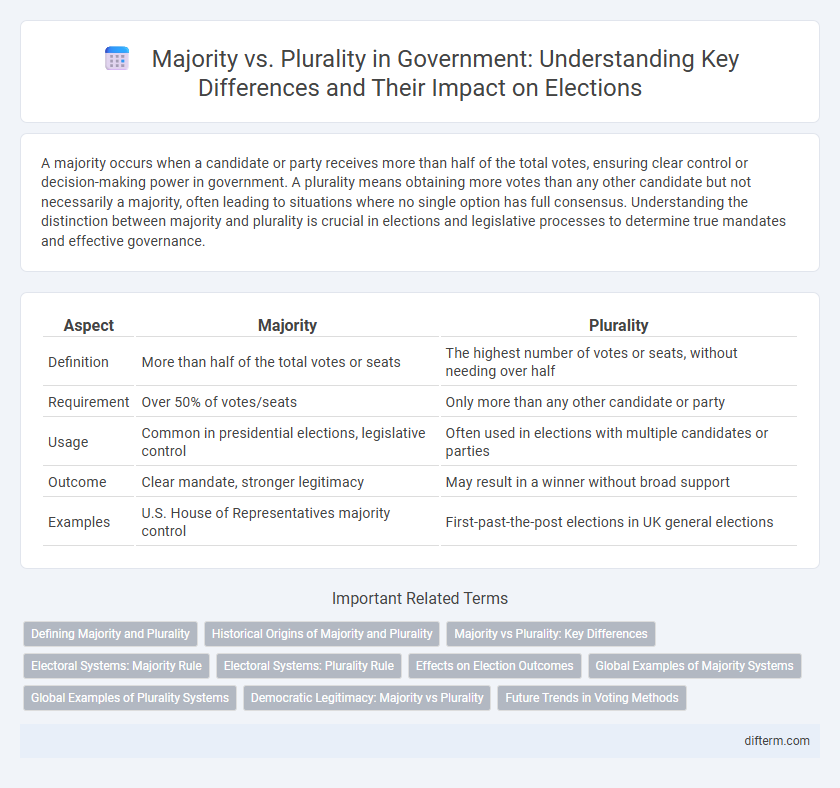A majority occurs when a candidate or party receives more than half of the total votes, ensuring clear control or decision-making power in government. A plurality means obtaining more votes than any other candidate but not necessarily a majority, often leading to situations where no single option has full consensus. Understanding the distinction between majority and plurality is crucial in elections and legislative processes to determine true mandates and effective governance.
Table of Comparison
| Aspect | Majority | Plurality |
|---|---|---|
| Definition | More than half of the total votes or seats | The highest number of votes or seats, without needing over half |
| Requirement | Over 50% of votes/seats | Only more than any other candidate or party |
| Usage | Common in presidential elections, legislative control | Often used in elections with multiple candidates or parties |
| Outcome | Clear mandate, stronger legitimacy | May result in a winner without broad support |
| Examples | U.S. House of Representatives majority control | First-past-the-post elections in UK general elections |
Defining Majority and Plurality
Majority refers to more than half of the total votes or seats in a government election, often required to pass legislation or secure executive positions. Plurality means having the highest number of votes or seats among competitors but does not necessarily exceed half of the total available. In parliamentary systems, majority control enables decisive governance, while plurality may lead to coalition-building.
Historical Origins of Majority and Plurality
The concepts of majority and plurality have historical origins rooted in democratic processes dating back to ancient Greece and Rome, where voting systems were developed to determine collective decisions. Majority rule emerged as the principle requiring more than half of the votes to ensure legitimacy and clear governance, while plurality acknowledged the candidate or option with the most votes even if not exceeding half. These foundational distinctions shaped modern electoral systems, influencing parliamentary procedures and democratic governance worldwide.
Majority vs Plurality: Key Differences
Majority refers to receiving more than half of the total votes, ensuring clear voter support, whereas plurality means securing the highest number of votes without necessarily surpassing half. Majority systems often lead to stronger mandates and greater political stability, while plurality systems can result in candidates winning despite lacking majority approval. Understanding the distinction between majority and plurality is crucial for analyzing electoral outcomes and governance effectiveness.
Electoral Systems: Majority Rule
Majority rule in electoral systems requires a candidate to receive more than half of the votes cast to win, ensuring broad support and legitimacy. This system contrasts with plurality rule, where the candidate with the most votes wins even without achieving an absolute majority, potentially leading to winners with less than 50% voter endorsement. Majority rule is commonly used in runoff elections, promoting consensus and stable governance by encouraging coalition-building among political parties.
Electoral Systems: Plurality Rule
Plurality rule in electoral systems elects the candidate with the highest number of votes, even if that total is less than an absolute majority, making it distinct from majority rule which requires over 50% support. This system often leads to a winner who secures more votes than any other candidate but not necessarily a majority, influencing the political landscape by favoring larger parties and potentially marginalizing smaller groups. Plurality voting is common in single-member district elections, where the simplicity of the rule can result in faster outcomes but may also prompt strategic voting and concerns about representativeness.
Effects on Election Outcomes
Majority systems require candidates to secure over 50% of votes, often leading to clear winners and stable governance. Plurality systems award victory to the candidate with the most votes, which can result in winners lacking majority support and fragmented mandates. These differences significantly influence political party strategies, voter behavior, and the overall representativeness of election outcomes.
Global Examples of Majority Systems
Majority systems are electoral frameworks where a candidate must secure more than half of the votes to win, commonly used in countries like France and Australia. In these systems, mechanisms such as runoff elections or preferential voting ensure that the elected official represents an absolute majority. This contrasts with plurality systems exemplified by the United Kingdom and the United States, where a candidate wins by having the most votes, even if not exceeding 50%.
Global Examples of Plurality Systems
Plurality systems, also known as first-past-the-post, are used globally in countries such as the United States, the United Kingdom, Canada, and India, where the candidate with the most votes wins even if they do not achieve an absolute majority. This electoral method often produces single-party governments and can marginalize smaller parties, influencing political stability and representation. Examples highlight how plurality rules shape legislative outcomes differently from majority systems that require more than 50% of votes to secure victory.
Democratic Legitimacy: Majority vs Plurality
Democratic legitimacy often hinges on whether a majority or plurality voting system is employed, as majority rule requires more than 50% of votes, ensuring broader consensus for governance. Plurality systems elect candidates with the highest number of votes, even without reaching a majority, which can lead to questions about representative legitimacy. The choice between these systems impacts the perceived fairness and stability of elected governments, influencing public trust and political cohesion.
Future Trends in Voting Methods
Future voting methods are increasingly adopting ranked-choice and proportional representation systems to move beyond simple plurality, aiming to better capture the true majority preference and enhance democratic legitimacy. Advances in digital voting technologies enable more accurate and transparent vote tallying, supporting complex majority calculations and reducing electoral disputes. These shifts reflect a growing trend toward inclusive governance models that prioritize majority consensus over mere plurality victories.
Majority vs Plurality Infographic

 difterm.com
difterm.com